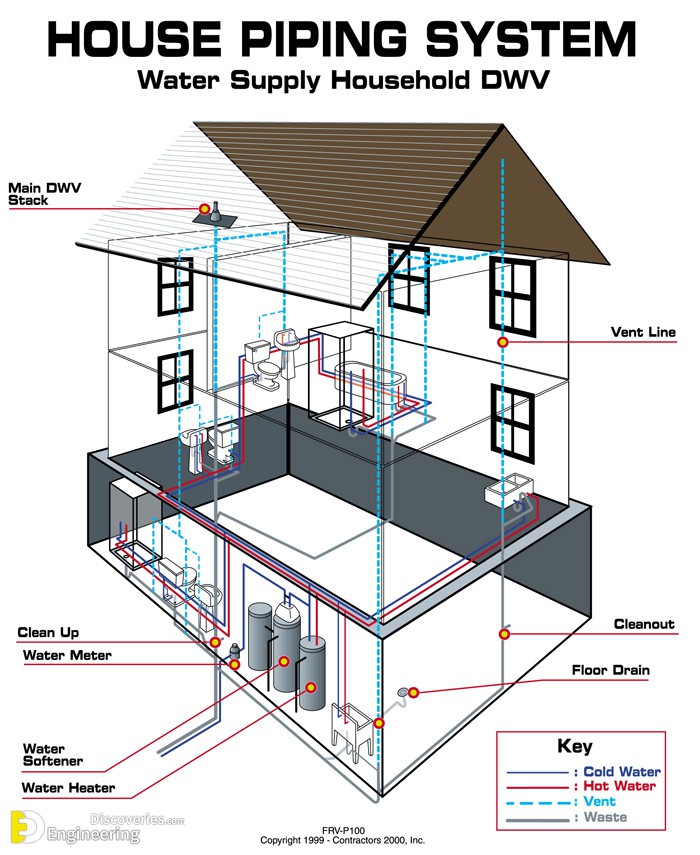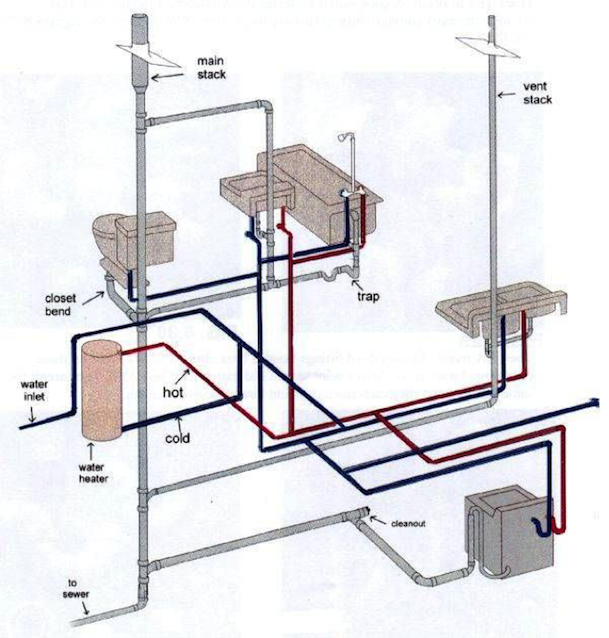Exploring The Layout of Your Home's Plumbing System
Exploring The Layout of Your Home's Plumbing System
Blog Article
They are making a number of great points on The Inner Workings of Your Home's Plumbing overall in this post on the next paragraphs.

Understanding exactly how your home's plumbing system works is essential for each home owner. From providing clean water for drinking, food preparation, and bathing to securely removing wastewater, a properly maintained plumbing system is critical for your family's health and convenience. In this extensive overview, we'll explore the detailed network that comprises your home's pipes and offer suggestions on maintenance, upgrades, and handling usual issues.
Introduction
Your home's pipes system is greater than simply a network of pipelines; it's a complex system that ensures you have access to tidy water and reliable wastewater elimination. Recognizing its parts and how they collaborate can help you avoid expensive repair work and ensure everything runs smoothly.
Standard Components of a Plumbing System
Pipes and Tubing
At the heart of your plumbing system are the pipes and tubes that carry water throughout your home. These can be constructed from various materials such as copper, PVC, or PEX, each with its advantages in terms of durability and cost-effectiveness.
Components: Sinks, Toilets, Showers, etc.
Fixtures like sinks, toilets, showers, and bathtubs are where water is made use of in your house. Understanding just how these fixtures attach to the pipes system aids in detecting issues and preparing upgrades.
Shutoffs and Shut-off Factors
Shutoffs manage the circulation of water in your plumbing system. Shut-off valves are important during emergencies or when you require to make repair services, allowing you to isolate parts of the system without interrupting water flow to the whole residence.
Water System
Key Water Line
The primary water line links your home to the local water supply or a private well. It's where water enters your home and is dispersed to different fixtures.
Water Meter and Pressure Regulator
The water meter procedures your water usage, while a stress regulator ensures that water flows at a secure stress throughout your home's pipes system, avoiding damages to pipelines and fixtures.
Cold Water vs. Hot Water Lines
Understanding the difference between cold water lines, which supply water straight from the primary, and hot water lines, which carry heated water from the water heater, aids in troubleshooting and preparing for upgrades.
Drain System
Drain Piping and Traps
Drain pipelines carry wastewater far from sinks, showers, and commodes to the drain or septic tank. Catches avoid sewer gases from entering your home and additionally catch particles that might cause obstructions.
Ventilation Pipes
Air flow pipes enable air into the water drainage system, stopping suction that might slow water drainage and trigger catches to empty. Correct ventilation is crucial for preserving the integrity of your plumbing system.
Relevance of Appropriate Drainage
Making certain proper water drainage avoids back-ups and water damage. Consistently cleaning drains and preserving catches can avoid pricey repairs and expand the life of your pipes system.
Water Heating Unit
Sorts Of Water Heaters
Hot water heater can be tankless or conventional tank-style. Tankless heaters warm water as needed, while containers keep warmed water for immediate use.
Just How Water Heaters Connect to the Pipes System
Recognizing exactly how hot water heater connect to both the cold water supply and warm water distribution lines assists in detecting issues like inadequate warm water or leaks.
Upkeep Tips for Water Heaters
Regularly flushing your water heater to eliminate debris, checking the temperature setups, and inspecting for leaks can expand its lifespan and enhance power efficiency.
Usual Plumbing Problems
Leakages and Their Reasons
Leaks can take place due to aging pipelines, loosened fittings, or high water pressure. Attending to leakages quickly stops water damage and mold and mildew development.
Blockages and Obstructions
Obstructions in drains pipes and commodes are often triggered by purging non-flushable products or an accumulation of oil and hair. Utilizing drain displays and being mindful of what decreases your drains pipes can prevent blockages.
Indications of Pipes Problems to Look For
Low water pressure, slow drains pipes, foul odors, or abnormally high water bills are indications of possible plumbing issues that need to be addressed quickly.
Pipes Upkeep Tips
Regular Assessments and Checks
Set up annual pipes evaluations to capture concerns early. Look for signs of leakages, rust, or mineral build-up in taps and showerheads.
Do It Yourself Upkeep Tasks
Basic jobs like cleansing tap aerators, looking for commode leakages utilizing color tablets, or protecting subjected pipes in chilly climates can avoid major pipes concerns.
When to Call a Specialist Plumbing Professional
Know when a pipes concern calls for expert know-how. Attempting intricate repair services without appropriate understanding can lead to even more damage and greater fixing costs.
Upgrading Your Pipes System
Factors for Updating
Updating to water-efficient components or changing old pipes can improve water high quality, minimize water expenses, and increase the worth of your home.
Modern Pipes Technologies and Their Advantages
Discover innovations like smart leak detectors, water-saving commodes, and energy-efficient hot water heater that can save money and lower ecological effect.
Expense Considerations and ROI
Compute the ahead of time expenses versus long-term financial savings when taking into consideration plumbing upgrades. Several upgrades pay for themselves through lowered energy bills and less repair services.
Environmental Influence and Conservation
Water-Saving Components and Home Appliances
Mounting low-flow faucets, showerheads, and toilets can dramatically minimize water usage without compromising efficiency.
Tips for Decreasing Water Use
Basic habits like dealing with leaks immediately, taking shorter showers, and running complete lots of laundry and dishes can save water and lower your energy bills.
Eco-Friendly Pipes Options
Consider sustainable pipes materials like bamboo for floor covering, which is durable and environment-friendly, or recycled glass for kitchen counters.
Emergency Readiness
Actions to Take During a Pipes Emergency
Know where your shut-off shutoffs are located and just how to shut off the water in case of a burst pipe or significant leak.
Value of Having Emergency Situation Contacts Helpful
Maintain get in touch with info for regional plumbers or emergency solutions readily available for fast response throughout a pipes crisis.
DIY Emergency Fixes (When Relevant).
Short-term repairs like making use of air duct tape to patch a dripping pipeline or putting a container under a trickling faucet can lessen damages until an expert plumbing technician arrives.
Verdict.
Understanding the composition of your home's pipes system equips you to keep it effectively, conserving money and time on fixings. By following routine upkeep regimens and remaining informed about modern plumbing technologies, you can ensure your pipes system runs successfully for years to find.
Understanding Your Home Plumbing System: A Comprehensive Guide
Plumbing System: The Lifeline of Your Home
At its core, the plumbing system is designed to perform two primary functions: bring fresh water into your home and remove wastewater. The system is a network of pipes, fixtures, and other components that transport water and sewage. Residential plumbing systems include potable water supply lines, drain-waste-vent (DWV) systems, and various plumbing fixtures that make water use in daily tasks possible.
Key Components:
Water Supply: This part of your plumbing system brings municipal water into your home, passing through the main water supply line. It s responsible for supplying all water needs, from drinking to bathing.
Drainage System: It carries waste and water away from your home to the sewer or septic system. This system includes all the piping within your home that leads to external sewage or septic systems.
Vent System: An essential yet often overlooked component, the vent system allows sewer gases to escape and lets air into the drainpipes, ensuring water and waste move correctly through the system.
Fixture: More Than Just Taps and Toilets
Plumbing fixtures are the most interactive parts of the plumbing system, including faucets, showers, toilets, and sinks. Each fixture is connected to the plumbing system and plays a role in either the delivery of freshwater or the disposal of waste and wastewater.
Types of Fixtures:
Faucets and Sinks: Used for washing hands, dishes, and other daily water needs.
Toilets: Dispose of human waste through the sewage system.
Bathtubs and Showers: Provide bathing facilities, requiring both hot and cold water supply.
Water Supply: The Source of Life
The water supply system is a critical component, ensuring that potable water is available throughout your home for various uses, including drinking, cooking, and cleaning. This system consists of pipes that distribute water to different parts of the house, controlled by valves to regulate the water flow.
Types of Plumbing: Materials and Methods
Various types of plumbing systems and materials are used in residential settings, each with its advantages and applications. From copper and PVC pipes for water supply to cast iron and ABS for drainage, the choice of materials can impact the longevity and efficiency of your plumbing system.
https://intownplumbingtx.com/articles/home-plumbing-system-guide/

Understanding Your Home Plumbing System: A Comprehensive Guide
Plumbing System: The Lifeline of Your Home
At its core, the plumbing system is designed to perform two primary functions: bring fresh water into your home and remove wastewater. The system is a network of pipes, fixtures, and other components that transport water and sewage. Residential plumbing systems include potable water supply lines, drain-waste-vent (DWV) systems, and various plumbing fixtures that make water use in daily tasks possible.
Key Components:
Water Supply: This part of your plumbing system brings municipal water into your home, passing through the main water supply line. It s responsible for supplying all water needs, from drinking to bathing.
Drainage System: It carries waste and water away from your home to the sewer or septic system. This system includes all the piping within your home that leads to external sewage or septic systems.
Vent System: An essential yet often overlooked component, the vent system allows sewer gases to escape and lets air into the drainpipes, ensuring water and waste move correctly through the system.
Fixture: More Than Just Taps and Toilets
Plumbing fixtures are the most interactive parts of the plumbing system, including faucets, showers, toilets, and sinks. Each fixture is connected to the plumbing system and plays a role in either the delivery of freshwater or the disposal of waste and wastewater.
Types of Fixtures:
Water Supply: The Source of Life
The water supply system is a critical component, ensuring that potable water is available throughout your home for various uses, including drinking, cooking, and cleaning. This system consists of pipes that distribute water to different parts of the house, controlled by valves to regulate the water flow.
Types of Plumbing: Materials and Methods
Various types of plumbing systems and materials are used in residential settings, each with its advantages and applications. From copper and PVC pipes for water supply to cast iron and ABS for drainage, the choice of materials can impact the longevity and efficiency of your plumbing system.
https://intownplumbingtx.com/articles/home-plumbing-system-guide/
Do you enjoy reading up on Plumbing Installation 101: All You Need to Know? Post feedback down below. We'd be delighted to know your thinking about this write-up. We hope to see you back again soon. In case you enjoyed reading our blog entry plz make sure you remember to pass it around. I thank you for your readership.
Free Estimate Report this page